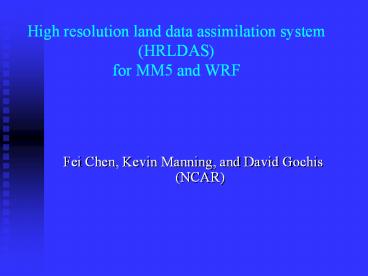High resolution land data assimilation system (HRLDAS) for MM5 and WRF - PowerPoint PPT Presentation
1 / 12
Title:
High resolution land data assimilation system (HRLDAS) for MM5 and WRF
Description:
Fei Chen, Kevin Manning, and David Gochis (NCAR) ... for convection initiation and intensification. for the 20 June 1998 dryline case ... – PowerPoint PPT presentation
Number of Views:211
Avg rating:3.0/5.0
Title: High resolution land data assimilation system (HRLDAS) for MM5 and WRF
1
High resolution land data assimilation system
(HRLDAS)for MM5 and WRF
Fei Chen, Kevin Manning, and David Gochis (NCAR)
2
Soil moisture initialization for NWP model
applications
- Initialization of soil moisture and temperature
is a challenge - Ultimate approach is to combine observation
(including satellite), modeling, and data
assimilation - Using observed rainfall, derived/analyzed
downward solar radiation, and atm analysis to
drive LSMs in uncoupled mode - NCEP NLDAS north America, 1/8 degree
- AFWA ARGMET global, 47-km
3
Soil moisturefrom EDAS and AGRMETat 12Z 31 May
2002
4
Latent and Sensible heat FluxWRF/Noah
Initialized by AGRMET and EDAS soil conditionsat
1800Z , May 31 2002
5
Soil moisture initialization for NWP model
applications
- Problems in using LDAS products in MM5 and WRF
- Mis-match of terrain, landuse, soil texture,
physical parameters used in LSMs - Adjusting soil moisture may mitigate this problem
- To initialize high-resolution MM5/WRF LSM
coupling system, we develop High-Resolution Land
Data Assimilation System (HRLDAS) - HRLDAS runs at the same grid as MM5/WRF
- No interpolation and soil moisture conversion
6
HRLDAS for IHOP
- Multi-resolution (4, 12 km) for the IHOP domain
- Utilize
- 4-km hourly NCEP Stage-II 1-km landuse type and
soil texture maps 0.5 degree hourly satellite
derived downward solar radiation monthly green
vegetation fraction T,q, u, v, from model based
analysis - Hourly product (Jan-July
- 2002)
4-km surface soil moisture Valid at 12 Z May 29
2002
7
Averaged diurnal cycle of Radiation forcing
verified with IHOP data
8
4-month (1998) HRLDAS soil moisture vs Oklahoma
Mesonet observation
5-cm
25-cm
9
MM5 4-h forecasted soil moisture on 3.3km grid
valid at 16Z 19 June 1998 (dryline case)
Soil moisture from HRLDAS
Soil moisture from NCEP EDAS
S. Trier, F. Chen, and K. Manning
10
Impact of soil moisture on QPF
3-h rainfall ending 00Z 19 June 1998 (dryline
case)
MM5 using soil moisture from HRLDAS
MM5 using soil moisture from NCEP EDAS coarse
resolution and too wet
S. Trier, F. Chen, and K. Manning
11
Important BL processes for
convection initiation and intensification for
the 20 June 1998 dryline case
Mesoscale circulation formed as result of
differential heating in the morning may be
responsible for CI in OK
Quasi-stationary convective rolls formed at the
dryline seem critical for CI
S. Trier, K. Manning, and F. Chen
12
NCAR WRF and HRLDAS plan
- WRF 22-km CONUS realtime forecast using EDAS and
AGRMET - Modify HRLDAS for WRF I/O framework
- Provide output in GRIB format for WRF users
- Set up realtime run for WRF
- Testing the interactive overland river routing
scheme and re-infiltration of standing water































